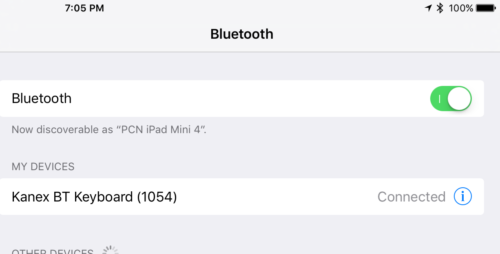Company: OtterBox
Price: $59.95

Continue reading “Review: Symmetry Series Folio for iPad Mini 4”

The personal blog of Peter Nikolaidis

Continue reading “Review: Symmetry Series Folio for iPad Mini 4”
Mini Bluetooth Keyboard
Price: $39.99
Company: Kanex
 I recently had the opportunity to review the Kanex Mini Bluetooth Keyboard with Stand Cover, and I have to say that I was impressed. Inside the box are the keyboard itself, a magnetic cover (which doubles as a stand for your tablet or phone), and a USB charging cable.
I recently had the opportunity to review the Kanex Mini Bluetooth Keyboard with Stand Cover, and I have to say that I was impressed. Inside the box are the keyboard itself, a magnetic cover (which doubles as a stand for your tablet or phone), and a USB charging cable.
 Pairing I the keyboard with my iPad Mini 4 was a breeze, as the keyboard appeared immediately in the iPad’s Bluetooth settings. I also paired the keyboard with my iPhone 5S to test, which worked a expected. However, I did have to make a few attempts to re-pair the keyboard with my iPad when I was done experimenting with the iPhone, as pairing with the iPad failed several times until I powered for the keyboard, told the iPad to forget it, and added it back as a new device.
Pairing I the keyboard with my iPad Mini 4 was a breeze, as the keyboard appeared immediately in the iPad’s Bluetooth settings. I also paired the keyboard with my iPhone 5S to test, which worked a expected. However, I did have to make a few attempts to re-pair the keyboard with my iPad when I was done experimenting with the iPhone, as pairing with the iPad failed several times until I powered for the keyboard, told the iPad to forget it, and added it back as a new device.
The keyboard itself performed very well, despite the fact that the keys are the size of Chicklets. Recall that it is the same width as an iPad Mini, so there isn’t a lot of real estate to play with. I did find myself occasionally hitting Enter when I was trying for other keys, and found the need to press the Fn key to get apostrophe and double quotes a bit odd at first, but I figured it out. Am I as fast a touch-typist on this as I am on a full-sized keyboard? Not even close. Am I a whole lot lot faster than using the iPad’s on-screen keyboard (either the Apple default or Google Gboard)? You betcha. However, if you have even slightly larger than average fingers, you could find yourself making a lot of typos and at the whim of autocorrect to save you.
Speaking of autocorrect, I found I was able to express myself fairly quickly and accurately with the Kanex. I was also amazed at how much faster it was for me to be able to Command-Tab from one app to another rather than double-clicking the home button to open the iPad’s built in task switcher view. One thing that always takes me a little getting used to is the fact that there is no mouse or trackpad. For some reason, there is still a disconnect for me between typing on a physical keyboard, and having to touch the screen to select icons or menus. That said, the Kanex supports common keyboard shortcuts, like Shift-arrows for selecting text, and Command-X and V for cutting and pasting a selection. The Fn key also provides the ability to invoke several extended commands, such as switching back to the home screen, cycling through apps with Command-Tab, and audio/video playback controls. Including Fn key combinations, I was able to find all of the keys normally found on a standard 101-key QWERTY keyboard.
Although it is fairly intuitive, the provided documentation (in English, Spanish, French, German, Chinese, and Japanese) does not show how to fold the case so as to function as a stand, although the there is a picture of it in stand mode on the box (which I did not notice, because I set the box aside as soon as I opened it). The cover itself magnetically sticks to the keyboard – which is brilliant – as well as itself, to stand up in a sort of tent on which to lean your tablet. You can easily separate the two pieces if you like, but they firmly adhere to each other for a stable typing experience, even when I have the unit on my lap.
Also not documented are the Fn key options to invoke iOS, Android, or Win modes. I noticed that selecting iOS allowed me to use the special commands to return to the Home screen, Find, or even lock the iPad. As I didn’t have an Android or Windows device handy to test this, I presume selecting these key combinations issues the appropriate command dependent on what operating system you select.
Kanex claims that the rechargeable battery will last for two months on a single charge. While I did not have any issues with the battery, I did not have time to put this two-month claim to the test.
Overall, the Kanex Mini Bluetooth Keyboard – on which this entire review was written – is a solid offering, and worth a look if you are in the market (or if you’ve just been typing on an iPad Mini and haven’t yet realized that you’re in the market).
After a few years of regularly co-hosting a podcast (Fresh Ubuntu, and Pocket Sized Podcast), I’ve partnered with my friend and colleague Adam Bell to record and publish Blurring the Lines! On the show, we will take about our experiences with business, as well as our personal lines, and how they blur in the 21st century. We also will have interviews with interesting guests on how the lines between their business and personal lives blur, how they maintain separation, and how they embrace the intersection. Give us a listen, and subscribe! Right now!
Recently, likely thanks to my weekly Saturday Binge Day posts on Facebook, several of my friends have been saying “I want to know more about that diet,” and also “I’m doing the same diet you are” or “my friend is doing the same diet you are.” My response? Yes/no.
Yes, you want to know more about it. No, you and your friends are not doing the same diet I am.
Continue reading “The "Peter Diet?" No, it's the Slow Carb Diet”
Data Rescue 4
Company: Prosoft Engineering
Price: $0 – $299
 I recently had the opportunity to review Data Rescue 4.2 from Prosoft Engineering, including a branded copy of their Bootwell USB thumbdrive.
I recently had the opportunity to review Data Rescue 4.2 from Prosoft Engineering, including a branded copy of their Bootwell USB thumbdrive.
From the publisher’s website: Data Rescue is hard drive recovery software that can recover your photos, videos, documents from:
Over the last few weeks, I’ve had the few different experiences on the importance of communication. Both of these involve to situations with vendors used by my business, both of them included circumstances that were in and out of the vendors’ control, and both of them were handled differently, with differing results. Continue reading “Two Examples of Communication Making ALL the Difference”
Man, time has been flying! ?I haven’t had time to update my blog, unless you mean “applying WordPress plugin updates,” which I have been doing. But what else has been going on? Continue reading “2015 in review”
For the last year, my company has been wrestling with a PSA – Professional Services Automation – tool named ConnectWise. Despite a year of effort – on our part and theirs – the tool has not worked effectively for us. What follows is my “last straw” email to ConnectWise.

Hello,
I think there was a bit of a misunderstanding, so please read the following email carefully and if there is any misunderstanding, call me directly so that I may clarify.
We have had it. We have been trying to make ConnectWise work for over a year, and it simply does not work for us. Let me clarify that I am not saying that when I double-click the icon, the program doesn’t fire up, although that has been the case at times. I mean that yes, your software has features and yes, technically, it could meet our needs, but it is so convoluted as to be nearly impossible to use effectively. We have been using ConnectWise for all of our client ticketing and timekeeping for over a year now, and it has been a miserable experience. It’s not that we don’t know the product or haven’t used it; we know it all too well and it’s time to step back and reexamine our position.
Not a week has gone by where either I or my operations manager were not cursing ConnectWise for one thing or another. I have been an IT professional for twenty years. I have used a computer since elementary school. I have served clients ranging from individuals with home computer problems to Fortune 10 corporations.
And never before have we felt such displeasure or disdain for a software solution.
Today I heard about the new features coming in 2015, and, with the exception of the new email features – which I admit do sound nice – they are a blatant attempt to catch up with Autotask’s new UI announced earlier this year. While a convoluted, complex, buggy UI has been a cause of much consternation among my staff, it does not end there. On the backend, we have experienced extremely poor performance. During the first several months of using the product, the desktop performance was ungodly poor. We were told to just use the web version. While this worked for my techs, it did me absolutely no good as my primary job functions required access to the sales, marketing, finance, and accounting interface features, which are not available on the web version. After the 2014 release, which admittedly improved performance, we still experienced other poor performance issues. Any attempts to update multiple activities take several seconds or sometimes even a minute to process, and when dealing with multiple activities throughout the day, day after day, these add up, especially when clients are on the phone and you’re waiting to get something done.
This leads me to another concern: The “ConnectWise way” of doing things seems to just assume that things are going to run slowly and take a long time to complete. It’s no wonder Arnie Bellini claims we will increase profits when it takes an extra 5% of time just to create and close a ticket entry! As someone who has historically run lean, mean, and with high profit margins, I cannot stand this cumbersome overhead that ConnectWise has added. Let me point out that I did not say ConnectWise is too “robust,” but when the lady on the phone suggested that was the problem, I decided to take the path of least resistance and just go with it. ConnectWise is too convoluted, cumbersome, and clunky. When experienced IT personnel who have been in the industry look at the screen to create a new ticket or “agreement,” and say “what the f— is that,” you don’t have a “robust” solution, you have a needlessly complex one.
There are other things that just do not align with our way of thinking. ConnectWise staff think nothing of using a “block time/one time” “agreement” to create a monthly recurring contract. In the language we use, using the phrase “one time” to describe a recurring contract is not just wrong – it is stupid. Similarly, it makes no sense to us that one would need to mark time as “billable” in an “agreement” where the client won’t be billed for it, yet that’s standard ConnectWise practice. Similarly, we call them contracts, not “agreements.” Don’t ask me why, but that has just rubbed us the wrong way from day one. We call them contracts, our colleagues call them contracts, and our clients call them contracts – in our world, they’re contracts. On that same note, we have clients, not customers – there is a difference.
Along those same lines, ConnectWise seems to assume that we will have a dispatcher, yet we do not. We’ve never needed to dedicate someone to this, as my staff have been intelligent and trustworthy enough to monitor and take tickets on their own. For a presently small organization such as ours, the additional overhead of a dedicated staff member just to handle dispatch is simply not practical.
Our onboarding process was rough, to say the least. There was a chasmic disconnect between us and our implementer, who did not seem to grasp core concepts to our way of doing business, such as a retainer. Note: in case this is a foreign concept to you, this is where someone pays us an amount of cash which we then work against until exhausted, at which point the retainer is replenished. This is a very common practice among professional services firms, yet our implementer appeared to have no concept of what we were talking about while trying to create these. At our implementer’s advice, we created several departments and roles and other things that we simply do not need. Our processes can be simply broken down into internal, sales, and support. We did not need so many departments and work roles and work types, and their creation simply caused confusion, wasted time, and billing errors (which we were still sorting out as of our last billing cycle).
Among this list of things that are just plain sloppy was a delinquent customer status which displayed a popup, informing the resource that the customer was far behind on payments, and to “offer to transfer the call to Rosanna.” There’s no Rosanna with us, but we assume there is – or was at one point – one with ConnectWise, and she lives on in the templates you’re supplying your customers.
Later on, when I asked about contractor accounts, I was told by my account rep that there was an option to use a contractor account, but that we really should use something called StreamlineIT because it was “exactly the same only cheaper.” With an offer like that, why would I ever choose a contractor account? Simple: because they’re NOT exactly the same. Only after setting up one of our contractors with a StreamlineIT account and finding out – In typical ConnectWise fashion, after several hours of troubleshooting and several confused clients – that it was because of this that invoices on which he worked were watermarked “for reference only.” Again, sloppy. Nobody selling your services should be telling your customers that two products are the same when they are clearly different.
Back to terminology again for a moment. I know you like to refer to us as “partners,” but we are not. We are not even your clients. We are your customers, and we are not happy. I would recommend you look up the definitions of these words in hopes that an understanding would bubble up to the top, but it is clear that the ConnectWise culture is set in stone and, again, it does not fit with ours.
Your mobile app… I’m going to save everyone’s time here and just say it’s a complete, utter joke.
Believe it or not, I could continue on for quite some time, but I would hope that, by this time, I have made my point.
Admittedly, given that ConnectWise i
s either the largest or second largest (it seems to depend on the day and who you ask) PSA in your space, obviously there are firms out there that use and love your product, and I am not denying this. However, we are not one of them. Due to the factors I’ve outlined, among others, it should be clear now that we are not a fit – something we have had to invest considerable time and money to discover.
We have done our part. We have made every effort to make ConnectWise work for us, to the point of even changing how we did business in an attempt to make it work for us, and that is just plain wrong. Your tool should work for your customers, not force them to bend to your methods.
At this point, we are making plans to move to another PSA. Prior to signing up, we were told that should we decide to leave, we would be provided with a MSSQL backup of our database. We would sincerely appreciate your cooperation in providing us with that at this time so that we can examine the data and prepare to import it into another system. We are hoping to migrate to another system by the end of the year, and would hope to terminate our agreement with ConnectWise at this time.
Thank you for your time, your understanding, and your assistance with this.
Peter
—
Peter Nikolaidis
CISSP, GCFE, GPPA, GSNA, SCA-UTM
Paradigm Consulting Co.
MA:617.517.2940 * NH:603.676.7119 * VT:802.234.6368
http://pa.radigm.com